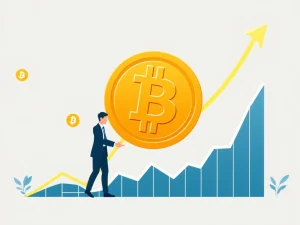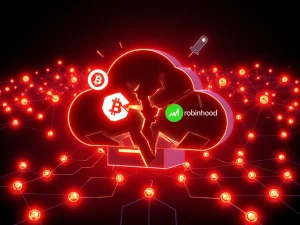Bitcoin Knots Growth: Alarming Signs Point to Potential Chain Split Risk

The Bitcoin network, long seen as a unified front, is showing signs of internal division. A significant surge in the adoption of the alternative client, Bitcoin Knots, is raising questions about the network’s future direction and potential stability. This isn’t just a technical squabble; it hints at ideological differences that could have real-world consequences for Bitcoin price.
Understanding Bitcoin Knots vs. Bitcoin Core
For years, the vast majority of nodes supporting the Bitcoin network have relied on the Bitcoin Core client. Developed by early figures like Luke Dashjr, Bitcoin Knots emerged as a more customizable and policy-flexible alternative. While Bitcoin Core often defines the de facto standards and relay policies, Bitcoin Knots allows operators greater control over what transactions they process and relay.
The recent data shows a dramatic shift. Since the beginning of the year, Bitcoin Knots node count has skyrocketed by 638%, jumping from 394 to 2,909 by June 19. This rapid growth, particularly accelerating in May, means Bitcoin Knots now accounts for over 13% of all publicly reachable nodes on the network. This isn’t a fringe movement; it’s a significant portion of the network infrastructure signaling dissent.
Why the Surge in Bitcoin Knots Nodes?
The primary driver behind this surge appears to be growing mistrust among some operators regarding Bitcoin Core‘s increasing influence on network policy. Critics argue that Bitcoin Core developers are moving towards a more restrictive relay policy, potentially limiting the types of transactions considered ‘standard,’ even if they are technically valid under consensus rules. This debate centers heavily on the use of the OP_RETURN opcode, which allows embedding small amounts of data in transactions and has been used for various applications, including Ordinals and BRC-20 tokens.
- Ideological Conflict: Some see Core’s proposed changes as an attempt to subjectively define what Bitcoin is ‘for,’ prioritizing financial transactions over data embedding.
- Neutrality Principle: Dissenters believe that if a transaction is valid by consensus rules and pays a fee, it should be relayed and mined without policy-level filtering.
- OP_RETURN Debate: Core is considering more restrictive handling of OP_RETURN (currently capped at 80 bytes), which Knots does not filter by default.
The growing adoption of Bitcoin Knots suggests that a meaningful segment of the network’s technical operators rejects Core’s perceived authority and is seeking a more neutral alternative.
Is a Chain Split on the Horizon?
This technical and ideological divide echoes the tensions seen in 2017, which ultimately led to the Chain split creating Bitcoin Cash. Back then, the disagreement was primarily over block size. Today, it’s about transaction policy and the fundamental nature of what should be allowed on the blockchain.
Bitcoin Core‘s proposed policy changes, potentially implemented around October 2025, could escalate the situation. If these changes cause Core clients to reject transactions or blocks that non-Core clients (like Knots) accept, it could lead to incompatible versions of the blockchain – the definition of a hard fork and a potential chain split. With over 13% of nodes already running Knots, this isn’t a small faction; it’s a significant portion of the network infrastructure that could diverge.
How Could a Chain Split Impact Bitcoin Price?
The 2017 fork provides some historical context, though the current market landscape is different. In 2017, the fork into BTC and BCH caused temporary volatility. Bitcoin price initially dipped around 5.6% but quickly recovered and surged significantly in the following months. The market ultimately sided with the original Bitcoin chain, and the split allowed dissenters to pursue their vision with Bitcoin Cash.
Today, the stakes are arguably higher. Bitcoin is integrated into mainstream finance through ETFs, corporations hold it on balance sheets, and the market cap is vastly larger. While the 2017 event showed resilience, a future chain split could introduce uncertainty. Analysts are watching closely:
- Short-Term Volatility: A split event could trigger immediate price fluctuations as traders react to the uncertainty.
- Investor Confidence: Questions about network unity and potential fragmentation could temporarily dampen investor sentiment.
- Market Choice: As in 2017, the market would ultimately decide which chain holds the most value, likely consolidating around the dominant version.
If Bitcoin Knots continues its current growth rate, potentially reaching over 20% of nodes by late 2025, the risk of a disruptive split increases. This dynamic tension within the network infrastructure is a critical factor to monitor for anyone invested in or following Bitcoin price.
Conclusion: Watching the Node War Unfold
The rapid growth of Bitcoin Knots is a clear signal that not all participants agree on the future direction of the network. The tension between Bitcoin Core‘s policy proposals and the desire for network neutrality is creating a divide reminiscent of past conflicts. While the outcome remains uncertain, the possibility of a chain split is real and could introduce volatility into the Bitcoin price. As October 2025 approaches, the cryptocurrency world will be watching closely to see how this internal debate plays out and whether Bitcoin can navigate this challenge without fracturing its foundation.









